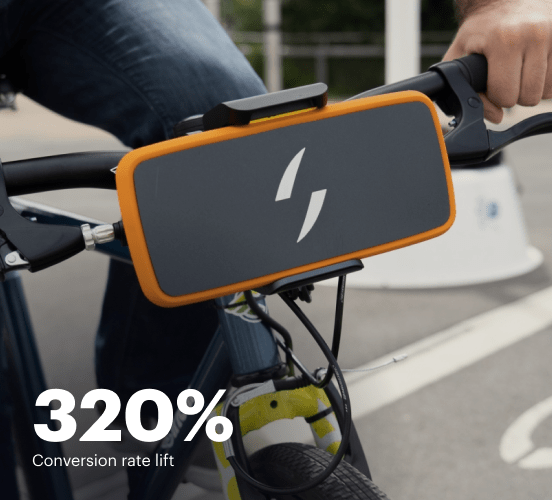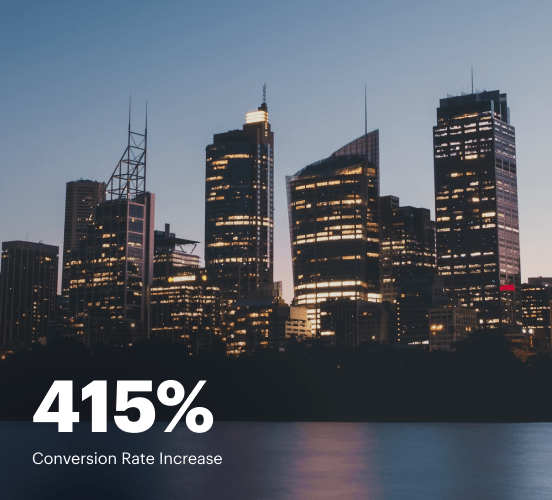How WordPress vs. Marketo vs. Instapage stack up against each other
Compare Instapage with WordPress and Marketo to create high-converting landing pages. With personalization, optimization, and collaboration tools, Instapage helps you deliver experiences that drive results.
Get startedSee how Instapage stacks up against the competition
| Feature | Instapage | Other builders |
| Drag-and-Drop Tools | ||
| Conversion-optimized templates | ||
| Manual and AI-powered A/B Tests | ||
| AI content suggestions | ||
| Popups and sticky bars | ||
| Canvas and grid blocks | ||
| Reusable and global elements | ||
| Form and popup builders | ||
| Built-in Heatmaps | ||
| Central analytics dashboard | ||
| Ad-to-page personalization and collections | ||
| Contacts, lists, and email | ||
| Dedicated, full-service CRO experts | ||
| Enterprise-ready platform |
Leading the way in building high-performing landing pages





Why Instapage is the smarter choice for your campaigns
Get everything you need to build, scale, and optimize high-converting landing pages—without coding.

Easier page building without coding
Instapage offers a flexible and seamless page creation experience with a library of 500+ conversion-focused layouts, Instablocks®, a drag-and-drop builder, and AI content generation. With technologies like Thor Render Engine®, you can create on-brand, mobile-responsive landing pages that load quickly and start converting during initial visitor clicks.

More insights — better results
Instapage lets you see in detail how each landing page experience and variation is performing so you can make targeted changes that boost page conversions. Use heatmaps for a better understanding of on-page activities, run A/B tests and AI-assisted experiments, and then track and evaluate results within robust analytics dashboards.

More personalized experiences
Instapage lets you quickly create high-performing landing pages tailored to each of your ad campaigns. Deliver personalized experiences for distinct audiences using dynamic text replacement. Effortlessly align specific advertisements to unique pages with AdMaps. Monitor audience-level metrics using our advanced data tools.

Built-in collaboration
Instapage collaboration capabilities bring your entire team together to speed up the process of landing page review, approval, and launch. No more frustrating and unnecessary revisions or edits scattered across emails. Provide instant feedback, conduct real-time page edits, and securely share your pages with outside stakeholders.

Free up time for your business
Invest time into business growth, not busy work. Launch landing pages faster with reusable forms and templates. Build once, reuse forever.
Explore all integrations






Easier page building without coding
Instapage offers a flexible and seamless page creation experience with a library of 500+ conversion-focused layouts, Instablocks®, a drag-and-drop builder, and AI content generation. With technologies like Thor Render Engine®, you can create on-brand, mobile-responsive landing pages that load quickly and start converting during initial visitor clicks.
More insights — better results
Instapage lets you see in detail how each landing page experience and variation is performing so you can make targeted changes that boost page conversions. Use heatmaps for a better understanding of on-page activities, run A/B tests and AI-assisted experiments, and then track and evaluate results within robust analytics dashboards.
More personalized experiences
Instapage lets you quickly create high-performing landing pages tailored to each of your ad campaigns. Deliver personalized experiences for distinct audiences using dynamic text replacement. Effortlessly align specific advertisements to unique pages with AdMaps. Monitor audience-level metrics using our advanced data tools.
Built-in collaboration
Instapage collaboration capabilities bring your entire team together to speed up the process of landing page review, approval, and launch. No more frustrating and unnecessary revisions or edits scattered across emails. Provide instant feedback, conduct real-time page edits, and securely share your pages with outside stakeholders.
Free up time for your business
Invest time into business growth, not busy work. Launch landing pages faster with reusable forms and templates. Build once, reuse forever.
Explore all integrationsGet started with Instapage in a few steps
-
Create your Instapage account
Start with Instapage by signing up via Google or your email. You'll get access to a free 14-day trial to discover Instapage capabilities. Feel free to cancel anytime during the 14-day trial if you decide that our product is not suitable for your business. -
Build and personalize your page
Create your first landing page from scratch or choose a template from 500+ customizable layouts. Use the drag-and-drop builder to add page elements, fonts, and backgrounds, refine content with AI, or add custom HTML, Javascript, and CSS. -
Review and make edits
Collaborate on page designs and streamline review processes. Invite your team members and stakeholders to review, edit, and provide feedback on your landing page. Collaborate knowing your page is confidential and only accessible to authorized users. -
Publish and track page performance
Publish your page to a domain or custom URL. Connect your pages to the ads you've created and track page performance within the analytics dashboard, run A/B tests and AI experiments, analyze results, and continuously optimize your landing page to maintain high conversions.
Instapage vs. WordPress vs. Marketo – The Ultimate Showdown for Marketers
Choosing the right landing page builder can feel like assembling the ultimate marketing dream team. Just as superheroes come with unique abilities, each platform brings something special to the table. Your marketing strategy deserves the perfect match, whether for high-converting landing pages or seamless user experiences. This article embarks on an informative yet engaging journey through the strengths of Instapage, WordPress, and Marketo, each of which has left its mark in the digital landscape. Buckle up for a rollercoaster of insights, comparisons, and a closer look at how these contenders measure up against one another. Get ready for an enlightening read that promises to help navigate these choices with ease and confidence. A perfect landing page experience is just a decision away!
Meet the Contenders: Who's Competing for Your Attention?
In one corner, we have WordPress, the heavyweight champion known for its versatility and robust plugin ecosystem. It's like the Swiss army knife of website creation, allowing users to craft everything from blogs to high-end eCommerce sites effortlessly. Then enters Marketo, a platform revered for its advanced marketing automation capabilities—ideal for businesses mindset toward lead nurturing and extensive analytics. Lastly, we have Instapage, which focuses solely on creating stunning and effective landing pages. While WordPress offers a broad array of functionalities and Marketo excels in automation, Instapage zeroes in on helping marketers create high-converting landing pages that deliver personalized experiences. These three platforms are friendly rivals on the digital playground, each vying for your love and attention in different ways. But which builder aligns best with your marketing objectives?
First Round - Feature Face-off
Template Variety and User Friendliness: A Closer Look
When it comes to features, each platform has its distinct advantages. WordPress boasts a staggering selection of themes and plugins, empowering users to customize their websites into almost anything they can dream. Its user-friendly interface allows beginners to dip their toes into web design, but it can be overwhelming for novices seeking straightforward solutions. Marketo offers impressive marketing automation features but tends to complicate the landing page creation process. Its strength lies in advanced analytics and detailed user tracking, which, while valuable, can obscure the simplicity some users crave. In contrast, Instapage shines with its dedicated focus on creating high-converting landing pages. With a plethora of versatile templates and an intuitive drag-and-drop editor, users can build effective pages rapidly, even if they're not technically savvy. The juxtaposition of strengths and weaknesses across these platforms indicates that while each has something to offer, their suitability heavily depends on specific user needs.
Instapage: The Champion of Customization and Conversion
Instapage truly stands out when it comes to customization and conversion optimization tools. The platform is designed with marketers in mind, providing unmatched capabilities for creating personalized landing pages that not only look stunning but also convert visitors into customers. Instapage empowers marketers to reduce costs associated with customer acquisition and increases conversions by enabling tailored experiences. With features like A/B testing, heatmaps, and dynamic text replacement, users can measure what resonates with their audience and adjust accordingly. This level of customization cultivates brand trust and customer loyalty, allowing marketers to forge a deeper connection with their users. By choosing Instapage, marketers are not just opting for a tool; they are enlisting a strategic partner in success, designed to boost conversion rates significantly.
Second Round - Speed and Performance: Who Wins?
Let’s talk speed! Picture this: you’re trying to grab your morning coffee, but the line is long and slow. That frustrating wait can spoil your entire day! Similarly, landing pages that take ages to load can deter potential customers. User experience hinges on speed—faster pages encourage exploration, while sluggish ones can cause exits. In this round, we’ll examine how each platform stacks up in delivering snappy performance that keeps users engaged.
Instapage Advantages:
- Optimized for lightning-fast loading times to reduce bounce rates
- Built-in AMP support for fast mobile landing pages that enhance user experience
- Real-time editing and publishing capabilities for immediate updates
- CDN integration to ensure high speeds globally
WordPress Advantages:
- Numerous caching plugins enhance site speed and user experience
- Flexible hosting options help optimize performance as needed
- Can be fine-tuned for speed through proper theme and plugin choices
Marketo Advantages:
- Robust cloud infrastructure that supports high-performance applications
- Optimized email deliverability speeds enhance overall campaign performance
- Scalable solutions that adjust based on user needs and traffic loads
In this high-paced comparison of speed and performance, Instapage takes the lead. Its laser focus on landing page creation allows for superior loading times, an essential factor in retaining visitors and driving conversions. While WordPress and Marketo have their strengths, their broader use cases might complicate performance optimization, making Instapage a prime choice for marketers keen on fast and effective results.
Third Round - Usability: Navigating New Waters
Diving into usability, each platform extends its unique hand of assistance to newcomers and seasoned pros alike. WordPress, with its vast array of features, invites users into its world, but may present a learning curve for those unfamiliar with website creation. However, countless tutorials and forums ensure that help is always at hand. Marketo focuses on marketing automation but can feel complex for those unseasoned in that sphere, often requiring a level of commitment to master its tools. On the other hand, Instapage boasts an intuitive interface that welcomes all users with open arms. The drag-and-drop functionality simplifies building landing pages, transforming the experience into a friendly adventure. Whether you are a novice marketer or an experienced professional, the platform ensures a smooth journey towards creating high-quality landing pages that resonate with audiences.
Fourth Round - Customer Support: Your Safety Net
Customer support is like your trusty sidekick, ready at a moment's notice – and each platform has its own style of offering assistance. WordPress, being open-source, relies on its community for support, providing a wealth of forums and tutorials alongside premium support options available from some themes and plugins. Marketo’s customer support shines with dedicated teams available through chat and email, making it a robust option for enterprise users needing quick solutions. Instapage rounds out the trio with its responsive support system. Users can count on real-time chat, email support, and an extensive knowledge base filled with articles and how-to guides. The emphasis on user support shows that whichever platform you choose, you’re never alone; help is just a few clicks away.
Fifth Round - Pricing and Plans: Finding Your Fit
Pricing structures can be as varied as the features offered. WordPress itself is free, but the costs can accumulate based on themes, plugins, and hosting options, potentially making it a complex budgeting game for some users. Marketo, on the other hand, operates on a subscription model, which might deter small businesses due to its higher price points but is justified by its comprehensive marketing automation capabilities. Instapage falls somewhere in between with straightforward pricing plans that align closely with its purpose: delivering excellent landing page performance. Each platform has unique pricing structures that cater to different audiences, making it crucial for potential users to weigh their options based on their unique needs and objectives. Instapage's value shines through with its focus on conversions and ease of use, providing an attractive solution for those prioritizing landing page effectiveness.
To wrap everything up, all three platforms boast unique strengths, catering to various marketing needs and goals. Remember, the right choice hinges on what you find most vital in a landing page builder. Whether it’s advanced features, solid customer support, or budget-friendly options, each contender has its place in your marketing toolkit. Take Instapage for a test drive with a free trial or demo, and experience the potential for reducing costs, growing conversions, and creating personalized landing page experiences that enhance brand trust and customer loyalty.










